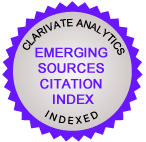Colonial visuality about the New World. Representation and imaginary of the Kingdom of Chile in Alonso de Ovalle‘s engravings (17th century).
-
Luciana Belén Pastor Martínez
 lucianapastormartinez@gmail.com
lucianapastormartinez@gmail.com
Downloads
Abstract
The Historical Relation of Chilean Kingdom by Alonso de Ovalle (1646), is a historical document that allows us to understand the visuality around the New World in the period of the Colony. The engravings as representations of the natural landscape and of the mapuche indigenous people that inhabit the South of Chile, are inserted in a historical context determined by the imaginaries that are configured on the New World; by the mechanisms of occidentalization and evangelization; and by the communicational reproduction of images in the European Baroque. This work aims to establish a dialogue between the historical, communicational and aesthetic dimension of this Jesuit publication.
Palabras Clave
BURKE, Peter (2001): Visto y no visto: El uso de la imagen como documento histórico. Barcelona: Crítica.
CACHEDA, Rosa (2013): “El Reino de Chile y las imágenes de la Histórica Relación de Alonso de Ovalle. Una aproximación a las Crónicas de Indias”, en BSSA A nº79: https://dialnet.unirioja.es/ejemplar/353748 (fecha de consulta: 29 de mayo de 2017)
FANON, Frantz (2001): Los condenados de la tierra. México: F.C.E.
GOMBRICH, Ernst (2008): La historia del Arte. Londres: Phaidon.
GRUZINSKI, Serge (1999): “Las imágenes, los imaginarios y la occidentalización”, en Para una historia de América I. Las estructuras. Ed. Marcello Carmagnani et all. México, F.C.E, pp. 298-567.
_____ (2003): La guerra de las imágenes. De Cristóbal Colón a Blade Runner (1492-2019). México: F.C.E.
NUNES, Clicie (2007): “Curiosidades coloniales en letra y trazo: una proyección mundializadora”, en Revista Chilena de Literatura 70: http://www.revistaliteratura.uchile.cl/index.php/RCL/article/viewFile/1445/1333 (fecha de consulta: 29 de mayo de 2017).
DE OVALLE, Alonso (1646): Histórica Relación del Reyno de Chile y de las misiones, y ministerios que exercita en la Compañía de Jesús. Roma: Francisco Cavallo.
PELIOWSKI, Amarí (2016): “La conquista de la naturaleza: el imaginario arquitectónico de Alonso de Ovalle en el siglo XVII”, en Revista ARQ 94: http://www.scielo.cl/scielo.php?script=sci_arttext&pid=S0717-69962016000300098 (fecha de consulta: 29 de mayo de 2017).
PRIETO, Andrés (2010): “Maravillas, monstruos y portentos: la naturaleza chilena en la Histórica relación del Reyno de Chile (1646), de Alonso de Ovalle”, en Taller de Letras 47:
https://repositorio.uc.cl/handle/11534/11676 (fecha de consulta: 31 de mayo de 2017).
RAMÍREZ, María del Mar (2009): “Información y contrainformación: la evolución de la imprenta en el periodo de la Reforma luterana y de la Contrarreforma”, en Análisi 39: https://dialnet.unirioja.es/servlet/articulo?codigo=3823940 (fecha de consulta: 31 de mayo de 2017).
ROJAS MIX, Miguel (2015): América Imaginaria. Santiago: Pehuén.
WALLERSTEIN, Immanuel (1979): El moderno sistema mundial: la agricultura capitalista y los orígenes de la economía-mundo europea en el siglo XVI. España: Siglo XXI.
Similar Articles
- Diana Mediavilla-Lomas, Juan-José Igartua, How queer social transgressive behaviours influence audiences , Perspectivas de la Comunicación: Vol. 17 (2024): January - December
- Gabriela Gallegos Martínez, Analysis of journalistic discourse about indigenous population: the case of Nuevo León, México. , Perspectivas de la Comunicación: Vol. 15 No. 2 (2022): July - December
- Carolina Mazzetti Latini, Between humor and taboo. Death in the communicational plot. , Perspectivas de la Comunicación: Vol. 14 No. 2 (2021): July - December
- Eugenia Blasetti, Emma Garzonio, The social representation of migrants during the COVID-19 pandemic. An Italian case study on hostile narratives and visual political communication , Perspectivas de la Comunicación: Vol. 15 No. 2 (2022): July - December
- Giovanna Gianturco, Francesca Colella, Identity, otherness, interculture: conceptual orientations between stereotypes and social imaginary , Perspectivas de la Comunicación: Vol. 15 No. 2 (2022): July - December
- Esteban Torres, The intercommunication system: from media to world social change , Perspectivas de la Comunicación: Vol. 16 No. 1 (2023): January - June
- Jorge Segundo Calbucura, The ethical-political construction of the past , Perspectivas de la Comunicación: Vol. 10 No. 1 (2017): Enero - Agosto
- Enrique Pérez Fumero, Yamile Haber Guerra, José Raúl Díaz López, Larisa Zamora Matamoros, A journalistic model. A theoretical interrelationship of new electronic journalism and Twitter platform in the Latin American media landscape. , Perspectivas de la Comunicación: Vol. 10 No. 1 (2017): Enero - Agosto
- Philippa Jane Page, Re-imagining Europe: local imaginaries, affect and the ever-thorny question of a continental identity [Bilingual edition: Spanish – English] , Perspectivas de la Comunicación: Vol. 11 No. 1 (2018): january - august
- Salomé Sola-Morales, Dra., Carla Quiroz, Mg., Representation of the role of women in the Chilean government discourse (1990-2016) , Perspectivas de la Comunicación: Vol. 11 No. 1 (2018): january - august
You may also start an advanced similarity search for this article.
Downloads
Published
How to Cite
Issue
Section
License
- Proposed policy to offer Open Access Journals
Authors who publish with this journal agree to the following terms:
a) Authors retain copyright and grant the journal right of first publication with the work simultaneously licensed under a Creative Commons Attribution Attribution (CC -BY 4.0) ![]() that allows others to share the work with an acknowledgement of the work's authorship and initial publication in this journal.
that allows others to share the work with an acknowledgement of the work's authorship and initial publication in this journal.
b) Authors are able to adopt licensing agreements for the non-exclusive distribution of the journal's published version of the work (for example, to post it to an institutional repositories or publish it in a monograph), with an acknowledgement of its initial publication in this journal.
c) Authors are allowed and encouraged to post their work online (For example, in institutional repositories or on their website) prior to and during the submission process, as it can lead to productive exchanges and increase the citation of published work (See The Effect of Open Access).











